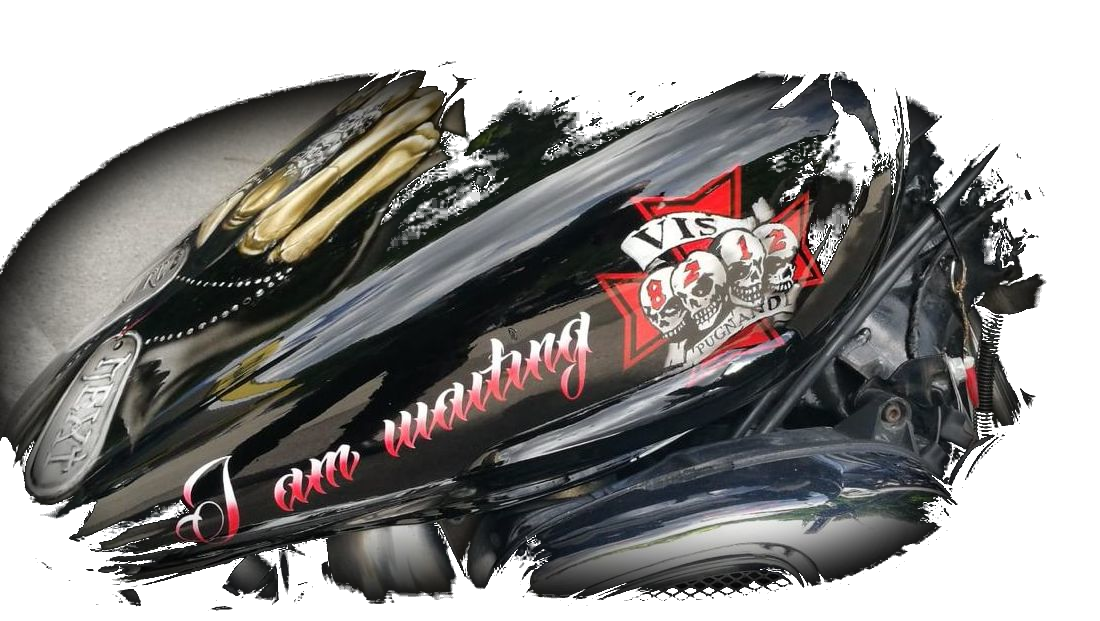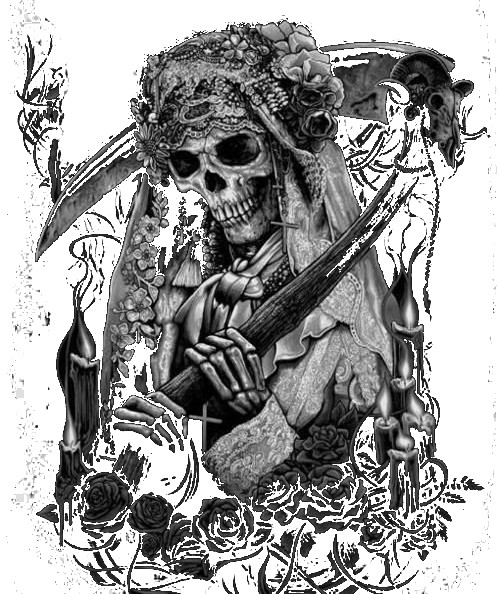

One of the most common symbols, both in the iconography of the biker world and in the field of tattoos, is certainly the skull. It is found everywhere, represented in a thousand ways, from the most dramatic horror-style designs to the most classic, traditional ones. It is often centralized and surrounding symbologies revolve around it, motorcycle or magical, terrifying or alchemical. Or instead it becomes an integral part of more complex logos and signs, almost always in the purely biker field.
The skull is normally understood as a bearer of different values: it can mean a warning, a philosophical warning - this is what you will become, what Life, Death and nothing more reserves for you - or a threatening signal of danger. In ancient times it stood at the entrance of the villages, to drive away evil and enemies, thus having the value of superstition and protection, as if the spirits of the dead were ready to take the field to fight with the inhabitants. Probably this is, at an unconscious and unconfessed level, the main motivation for tattooing a skull, that of remembering dead friends or family members with a tribute and requesting supernatural support in return. Entering this particular area we must remember the "calaveras", the typical Mexican and South American skulls. Their presence is fundamental on the Day of the Dead, when the population celebrates with great celebrations, dances in the square and pilgrimages to the cemeteries to bring gifts, food and flowers to the graves. The playful aspect of the iconography certainly descends from Santa Muerte, the female divinity of the afterlife - positive, given that she is the companion of the dark side, what we would call Hades, that is Xibalba, who instead commands the kingdom of the forgotten, a variant of our hell where the souls who no longer have anyone to pray for them disappear.

Santa Muerte is a cult that can be connected, and derives in part, from brujeria and santeria, the latter comparable to our witchcraft and Haitian voodoo rituals. It is said to have begun in the early 2000s by Dona Quieta who erected a small sanctuary in the infamous Tepito neighborhood in Mexico City, which immediately became a destination for curiosities and pilgrimages, but anthropologists refer the cult to ancient tribal practices. Santa Muerte, depicted as a skeleton woman, and in the tattoos as a beautiful female face partly skull and partly human; it is the divinity of the poor, ready to satisfy neither psychological pains nor to soothe the torments of sinners, but rather the most concrete requests for money, luck, popularity, victory over enemies. Not for nothing adopted and revered by all the cartels of the narcos and by the lower strata of the population, it has spread like wildfire everywhere and thanks to the fascinating iconography of the female skull, Santa Muerte tattoos have been an unmissable must for decades for industry aficionados.

In the skull of Santa Muerte erotic impulses, desire and requests converge. An explosive mix that cannot fail to strike the collective imagination. Quite bizarre, little studied but very interesting, is the mixture that has been created, wherever the cult of Santa Muerte is followed, with Christian religiosity and its saints, in particular with what is almost ignored by us while elsewhere, especially in America of the north and south, he is much loved: Saint Jude Thaddeus. Continuously confused with Judas the Iscariot and neglected by the majority of the faithful Saint Judas, the apostle cousin of Jesus, is the so-called "saint of the impossible" and those afflicted with problems so serious as to be impossible, in fact, have always turned to him. be solved in the common ways. In North America, among other things, he is also the protector of the guards - we find him mentioned in the film "The untouchables" by De Palma, and in "Man on fire" where his medal accompanies the protagonist towards an extreme sacrifice of redemption.
The cult of St. Jude has always been plagued by a paucity of news but scholars show him as the bearer of the "Mandilion" towards the kingdoms of the east, the strip of fabric on which the Holy Face of the Redeemer was imprinted, which served to protect the cities besieged by enemies, and to convert pagan rulers who saw it. It is therefore remarkable how this saint, who carries with him the image of a face, indeed almost of a skull, ended up next to a living skull such as Santa Muerte, and became the second most venerated saint in South America after her. . There are several churches of St. Jude Thaddeus also in Italy; few and rare also the relics that testify to it, some preserved in the left wing of St. Peter's basilica, in addition to the Mandilion on which there would be a lot to discuss as there would be different fabrics that miraculously bear the face of Christ, starting with that hidden in the Vatican and now extremely consumed, to the one called "Holy Face of Manoppello", which Pope Benedict XVI visited, still visible and venerated by the public.

There are also tales of a miraculous reliquary that belonged to a Neapolitan cardinal containing fragments of St. Jude, St. Maria Francesca, St. John Joseph of the Cross and the veil of the Blessed Virgin Mary, but traces of it have been lost many years ago. As you can see, the iconography of the skull, from that simply frightening image known to most, manages to conceal infinite other facets within itself, which invest profound religiosity, honor and respect for those who are no longer there, courage to wear the sign of the fighting spirits, the pagan sexuality of Santa Muerte, even a deviated semblance of the face of Christ conveyed by the one who was its apostle and diffuser, St. Jude. Many things that no one thinks locally, sometimes just for fashion, sometimes with a very different spirit.
Papa Doc for MPM GENS